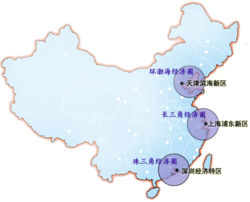The scale of that urbanization has no precedent, with as many as about 600 million people moving to the cities in the next 20 years, Shen says. While authorities are encouraging farmers to migrate to local small towns rather than overcrowding large cities, migrant workers will likely follow job opportunities. As a result, Shen thinks the urbanization will occur in megaregions or urban zones, in part because of the development of high speed rail systems and also because of where college student enrollment is high.
“Five mega-regions may gradually emerge as the key centers of urbanization, led by what we term the “XYZ” urban zones in the Pan Bohai Bay Area (X), Pearl River Delta (Y, including Hong Kong and Macau) and Yangtze River Delta (Z). These three regions accounted for 28% of China’s population and 41% its GDP in 2011, and will likely gain further in the next two decades given their locational advantages,” he writes.
Nextbigfuture has covered the Bohai and other emerging megaregions of China.
The three major economic mega-urban zones are the pearl river delta in the south (merging into one 42 million person city) and Yangtze River delta around Shanghai and the Bohai economic rim
The area around Beijing and Tianjin, two of China’s most important cities, is being ringed with a network of high-speed railways that will create a super-urban area known as the Bohai Economic Rim. China is merging Beijing/Tianjin and several other cities around the Bohai Sea into one big super-urban zone over the next several years. By 2020 there could be 260,000,000 people (3% of the world’s population) in one big super-city.
Here is translation of a plan for the development of the Bohai Economic Rim.
The process of merging the Bohai region has already begun with the connection of Beijing to Tianjing by a high speed railway that completes the 75 mile journey in less than half an hour, providing an axis around which to create a network of feeder cities.
Inland China that is trying to catch up with the country’s more popular coastal cities is following a different path of growth, rooted in infrastructure investment funded by bank loans. Non-performing loans in inland banks may rise as a result of any economic slowdown.
The pace of reforms will likely determine the rate of urbanization, but the “urbanization dividend” should support sustained growth of 6-8% in the coming decade.
Nextbigfuture has covered previous reports of sustained GDP growth in China’s inland areas.
New middle class and affluent will be in Tier 3 cities in the interior
If you liked this article, please give it a quick review on ycombinator or StumbleUpon. Thanks

Brian Wang is a Futurist Thought Leader and a popular Science blogger with 1 million readers per month. His blog Nextbigfuture.com is ranked #1 Science News Blog. It covers many disruptive technology and trends including Space, Robotics, Artificial Intelligence, Medicine, Anti-aging Biotechnology, and Nanotechnology.
Known for identifying cutting edge technologies, he is currently a Co-Founder of a startup and fundraiser for high potential early-stage companies. He is the Head of Research for Allocations for deep technology investments and an Angel Investor at Space Angels.
A frequent speaker at corporations, he has been a TEDx speaker, a Singularity University speaker and guest at numerous interviews for radio and podcasts. He is open to public speaking and advising engagements.






